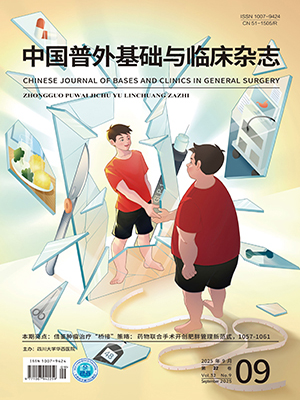| 1. |
任建安, 黎介壽. 嚴重腹腔感染的綜合治療. 中國實用外科雜志, 2007, 27(12): 940-942.
|
| 2. |
Singer M, Deutschman CS, Seymour CW, et al. The third international consensus definitions for sepsis and septic shock (Sepsis-3). JAMA, 2016, 315(8): 801-810.
|
| 3. |
Jacob JA. New sepsis diagnostic guidelines shift focus to organ dysfunction. JAMA, 2016, 315(8): 739-740.
|
| 4. |
Perner A, Cecconi M, Cronhjort M, et al. Expert statement for the management of hypovolemia in sepsis. Intensive Care Med, 2018, 44(6): 791-798.
|
| 5. |
Fleischmann C, Scherag A, Adhikari NK, et al. Assessment of global incidence and mortality of hospital-treated sepsis. Current estimates and limitations. Am J Respir Crit Care Med, 2016, 193(3): 259-272.
|
| 6. |
Vincent JL, Sakr Y, Sprung CL, et al. Sepsis in European intensive care units: results of the SOAP study. Crit Care Med, 2006, 34(2): 344-353.
|
| 7. |
中國醫師協會急診醫師分會, 中國研究型醫院學會休克與膿毒癥專業委員會. 中國膿毒癥/膿毒性休克急診治療指南(2018). 臨床急診雜志, 2018, 18(9): 567-588.
|
| 8. |
Boldingh QJ, de Vries FE, Boermeester MA. Abdominal sepsis. Curr Opin Crit Care, 2017, 23(2): 159-166.
|
| 9. |
徐麟, 石鑫, 李蓋天, 等. 損傷控制理論在腹腔膿毒癥中的應用進展. 中國普外基礎與臨床雜志, 2019, 26(2): 253-256.
|
| 10. |
周波, 任建安. 腹腔開放療法研究進展. 中國實用外科雜志, 2016, 36(2): 248-251.
|
| 11. |
Kirkpatrick AW, Roberts DJ, De Waele J, et al. Intra-abdominal hypertension and the abdominal compartment syndrome: updated consensus definitions and clinical practice guidelines from the World Society of the Abdominal Compartment Syndrome. Intensive Care Med, 2013, 39(7): 1190-1206.
|
| 12. |
Hirasawa H, Oda S, Nakamura M. Blood glucose control in patients with severe sepsis and septic shock. World J Gastroenterol, 2009, 15(33): 4132-4136.
|
| 13. |
Englert JA, Rogers AJ. Metabolism, metabolomics, and nutritional support of patients with sepsis. Clin Chest Med, 2016, 37(2): 321-331.
|
| 14. |
尚麗明, 唐華民, 李仕來, 等. 應用不同類型引流裝置治療創傷后腸瘺的對比研究. 創傷外科雜志, 2017, 19(9): 654-656.
|
| 15. |
保紅平, 姚永良, 高瑞崗, 等. 腹腔雙套管持續沖洗負壓引流技術在腹部外科的臨床應用. 中國普外基礎與臨床雜志, 2011, 18(12): 1323-1324.
|
| 16. |
Boomer JS, Green JM, Hotchkiss RS. The changing immune system in sepsis: is individualized immuno-modulatory therapy the answer? Virulence, 2014, 5(1): 45-56.
|
| 17. |
Delano MJ, Ward PA. Sepsis-induced immune dysfunction: can immune therapies reduce mortality? J Clin Invest, 2016, 126(1): 23-31.
|
| 18. |
Delano MJ, Ward PA. The immune system’s role in sepsis progression, resolution, and long-term outcome. Immunol Rev, 2016, 274(1): 330-353.
|
| 19. |
Ou L, Chen J, Hillman K, et al. The impact of post-operative sepsis on mortality after hospital discharge among elective surgical patients: a population-based cohort study. Crit Care, 2017, 21(1): 34.
|
| 20. |
Bosmann M, Ward PA. The inflammatory response in sepsis. Trends Immunol, 2013, 34(3): 129-136.
|
| 21. |
Coccolini F, Roberts D, Ansaloni L, et al. The open abdomen in trauma and non-trauma patients: WSES guidelines. World J Emerg Surg, 2018, 13: 7.
|
| 22. |
任建安. 腹腔開放療法在腹部創傷的應用. 創傷外科雜志, 2015, 17(3): 193-196.
|
| 23. |
Carlson GL, Patrick H, Amin AI, et al. Management of the open abdomen: a national study of clinical outcome and safety of negative pressure wound therapy. Ann Surg, 2013, 257(6): 1154-1159.
|
| 24. |
張昕. CT 機定位下穿刺引流治療嚴重腹腔感染合并腹腔膿腫療效研究. 河北醫學, 2015, 21(7): 1079-1081.
|
| 25. |
Rivera-Sanfeliz G. Percutaneous abdominal abscess drainage: a historical perspective. AJR Am J Roentgenol, 2008, 191(3): 642-643.
|
| 26. |
Levin DC, Eschelman D, Parker L, et al. Trends in use of percutaneous versus open surgical drainage of abdominal abscesses. J Am Coll Radiol, 2015, 12(12 Pt A): 1247-1250.
|




